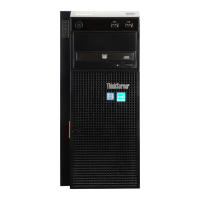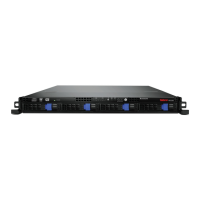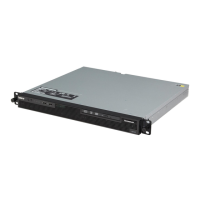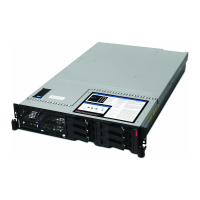Note: If the operating system is installed on a SAN, ensure that you select the drive on the SAN in the
following steps.
• To create a drive partition, do the following:
a. Click Partitioning and select Custom Partitioning (for experts). Click Next.
b. In the Expert Partitioner window, select Hard Disks ➙ sda in the System view area, and then
click Add.
c. In the New Partition Size window, select Custom Size and type 20GB in the Size area, and then
click Next.
d. In the Format partition area, select Ext3 from the File System drop-down list box.
e. In the Mounting partition area, select the forward slash / from the Mount Point drop-down list
box. Then, click Finish. The root partition is created.
f. Go back to the Expert Partitioner window. Select Hard Disks ➙ sda in the System view area, and
then click Add.
g. In the New Partition Size window, select Custom Size and type 1GB in the Size area, and then
click Next.
h. In the Format partition area, select FAT from the File System drop-down list box.
i. In the Mounting partition area, select /boot/efi from the Mount Point drop-down list box. Then,
click Finish. The boot partition is created.
j. Go back to the Expert Partitioner window. Select Hard Disks ➙ sda in the System view area, and
then click Add.
k. In the New Partition Size window, select Custom Size and type 1GB in the Size area, and then
click Next.
• In the Format partition area, select Swap from the File System drop-down list box. In the Mounting
partition area, the item becomes to Swap automatically in the Mount Point drop-down list box.
Then, click Finish. The swap partition is created.
10. Go back to the Expert Partitioner window. Ensure that the drive partition is correct and click Accept.
11. In the Installation Settings window, click Software to select your desired software programs, and then
click OK. If the YaST window is displayed, click Accept.
12. Click Install to install the software programs that you have selected.
Note: If the warning window is displayed, configure the settings as you need, and then click OK and
TryAgain. If the YaST window is displayed, click Accept. Then go back to the Installation Settings
window and click Install. If the YaST2 window is displayed, click Install.
13. The setup process continues after the server restarts. Set your root user password and click Next. If the
YaST2 window is displayed, click Yes.
Note: The password must contain at least six characters and consist of upper case letters, lower case
letters, and numbers.
14. Set your host name and domain name. Then, click Next.
15. Configure your network in the Network Configuration window. Then, click Next.
16. In the Test Internet Connection window, configure the settings as you need. Then, click Next. The
following steps are based on the scenario that No. Skip This Test is selected in this step.
17. In the Network Services Configuration window, click Next.
18. In the User Authentication Method window, configure the settings as you need. Then, click Next. The
following steps are based on the scenario that Local (/etc/passwd) is selected in this step.
19. In the New Local User window, configure the settings as you need. Then, click Next.
20. In the Release Notes window, click Next.
Chapter 3. Installing an operating system in UEFI mode 67

